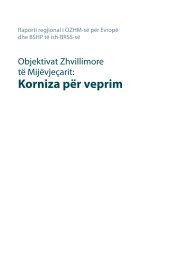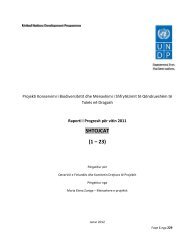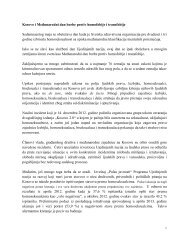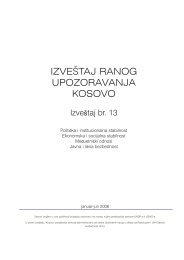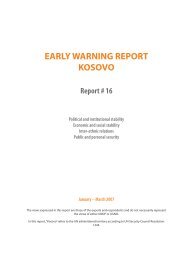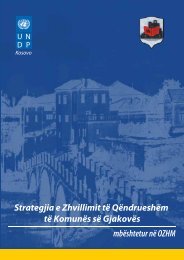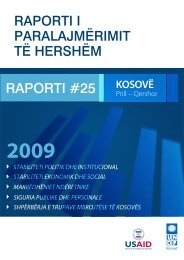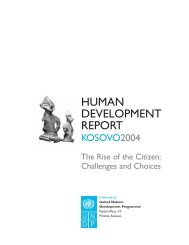Kosovo Human Development Report 2010 - UNDP Kosovo - United ...
Kosovo Human Development Report 2010 - UNDP Kosovo - United ...
Kosovo Human Development Report 2010 - UNDP Kosovo - United ...
You also want an ePaper? Increase the reach of your titles
YUMPU automatically turns print PDFs into web optimized ePapers that Google loves.
2. Disadvantaged children and<br />
youth: the young have the least<br />
economic and social power to<br />
break out of exclusion; it damages<br />
their life opportunities almost<br />
beyond repair and creates generational<br />
traps. <strong>Kosovo</strong>’s excluded<br />
young people are members<br />
of poor families or families with<br />
a long-term unemployed wage<br />
earner, part of <strong>Kosovo</strong>-RAE communities,<br />
part of communities<br />
without sufficient access to services,<br />
environmental protection or<br />
information, those living in remote<br />
or rural areas and girls subjected to<br />
restrictive cultural practices. Young<br />
people are affected by economic<br />
factor market exclusion, with 48<br />
percent classed as poor compared<br />
to a 45 percent <strong>Kosovo</strong> average.<br />
Youth unemployment rates stand<br />
at 73 percent, more than half as<br />
much again as the <strong>Kosovo</strong> average<br />
of 43 percent. Exclusion from<br />
education is a particularly grave issue<br />
for minority children trapped in<br />
parallel systems, paying the price<br />
for <strong>Kosovo</strong>’s history of exclusion,<br />
as well as for girls in the context<br />
of diminishing gender parity in<br />
the classroom. Children of ethnic<br />
minorities are particularly badly affected<br />
by ostracization, lack of parental<br />
prioritization and the inability<br />
to attend school in a local language.<br />
The absence of high quality<br />
health information and adequate<br />
maternal, child, adolescent and<br />
reproductive health outreach for<br />
disadvantaged young people creates<br />
health and nutrition problems<br />
for many. Smoking, poor hygiene<br />
and unhealthy eating undermine<br />
their development, with just under<br />
one in seven stunted for their age<br />
and approximately one in six weak-<br />
ened by anaemia. Young people<br />
are deeply conscious of their exclusion,<br />
reflected in diminishing voting<br />
patterns among young voters<br />
and a decrease in political activism<br />
despite a clear and still untainted<br />
desire to make a contribution to<br />
their society and work together<br />
across ethnic and cultural divides.<br />
3. Rural women: <strong>Kosovo</strong>’s de facto social<br />
exclusion of women’s potential is a key<br />
factor in its economic decline and<br />
uncompetitive labour market. Labour<br />
force participation for women<br />
is 26.1 percent, compared to 65.8<br />
percent for men and a European<br />
average of 64 percent. Women<br />
have higher unemployment rates<br />
than men and few other income<br />
sources, gravely limiting their access<br />
to factor markets (only 6 percent<br />
of business owners, for example,<br />
are women). Rural women in<br />
particular are most likely to be confined<br />
to subsistence living as well as<br />
being more likely to be illiterate and<br />
less able to access the services and<br />
information to which they are entitled.<br />
Factors that exclude rural areas<br />
in general from equal access to<br />
quality services (such as distance<br />
to services, poverty, cost of transport<br />
etc) are felt particularly hard<br />
by rural women and girls. These<br />
women and girls carry the greatest<br />
burden of work at home and are<br />
often forbidden to expand their<br />
horizons. Thus, women’s health<br />
and nutrition is more likely to suffer<br />
in rural areas, with low rates of<br />
exclusive breastfeeding, high rates<br />
of smoking, high rates of anaemia<br />
(23 percent) and lower levels of<br />
education. Exclusion of rural women<br />
in this way not only holds back<br />
the development of rural areas, but<br />
FINDINGS AND RECOMMENDATIONS | 95



